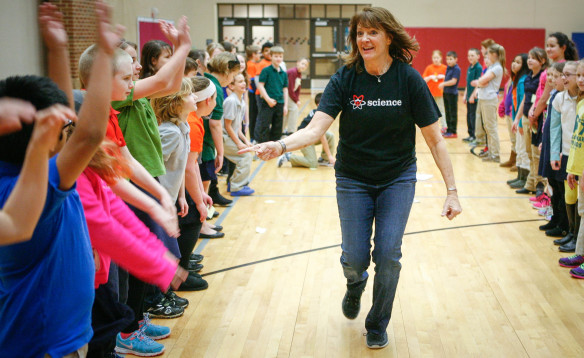
Sharon Roberson, a science lab teacher at Brooks Elementary (Bullitt County) demonstrates sound waves by having students do the wave during a lesson on the science of music.
Photo by Mike Marsee, Feb. 19, 2016
By Mike Marsee
michael.marsee@education.ky.gov
Most students know how to make noise and many of them know how to make music. Sharon Roberson’s 4th-grade students now know a little more about making sound as well.
Roberson recently led a lesson that gave her students at Brooks Elementary (Bullitt County) a look at how sounds are made, how sound travels and what the shape of a melody can look like.
Roberson, a science lab teacher, and one of her colleagues developed the lesson as an effort to bring music into the science classroom, adapting ideas she had gotten at a conference last year and adding some of her own to combine two disciplines that she said can complement each other.
“It makes stronger connections for students. They can apply the material in broader and deeper terms when you make those connections,” Roberson said.
Roberson wrote in the introduction of her lesson plan that science and music might be taught in classrooms, but that isn’t the case outside the school.
“Often we teach skills or concepts in isolation, but in the real world, they are not separate. Science and art happen together when we create and enjoy music. Music builds science and science builds music,” she wrote.
Three months earlier, Jason Spencer was making the same point to a room full of teachers, including Roberson, at the Kentucky Science Teachers Association’s annual conference. Spencer, the education director with the Lexington Philharmonic, led sessions at the conference that detailed how music can be integrated into STEM classrooms.
“I think it’s such an important idea for teachers to consider incorporating music into the curriculum,” Spencer said.
Spencer showed the teachers a version of the program he takes to schools in which he illustrates the sounds that can be created using varied amounts of water in glasses and do-it-yourself instruments such as “harmoni-kazoos” made from Popsicle sticks and rubber bands, kazoos made from drinking straws and a “drumbone” made from PVC pipe. He also used objects such as an extra-long Slinky to demonstrate frequency, wavelength and vibration.
He said his audience of teachers, who tried out some of those objects, wasn’t much different from a typical group of students.
“It’s no different than the kids. There was a lot of giggling, laughing, talking to their neighbors and saying, ‘Listen to this.’ It’s just really, really fun,” he said.
Spencer cited studies showing that blending science and the arts can increase student engagement and help students develop problem-solving and creative thinking skills. He offered his services, but also said he hoped teachers would at least take “one or two ideas” that they could apply in their classrooms.
Roberson did that at Brooks Elementary, teaming with music teacher Ryan Meeks to develop the lesson and enlisting the help of physical education teacher Emily McWaters for a class that incorporated some of Spencer’s ideas and a few of theirs. It was a collaborative project that Roberson said is typical at their school.
“I think we’re very blessed in that all of us here are pretty cooperative. We’re a team, just like a grade-level team. We do several cooperative lessons through the year, so that part wasn’t a hurdle,” Roberson said.
Meeks opened the lesson by introducing a handful of instruments, from percussion to woodwind to stringed, and demonstrating how each produced sound. Roberson then put the students in two lines and had them do the wave, which is frequently seen at large sporting events, to show them how sound waves travel.
Then the students were separated into three groups, in which they made straw kazoos and observed the resulting sound waves using an iPad app, listened to a melody played on a recorder and drew a visual representation of that melody and experimented with changing sounds and pitches and volumes using xylophones.
“You can’t have the science of sound without music, and you can’t have sound without science,” Roberson told the students.
Both she and Meeks said they thought the lesson was a success.
“I think it went very well,” Meeks said.
Roberson said she would like to expand the lesson in the future beyond a single class period.
“I’d like to talk about how science connects with music in the brain, and we just didn’t have time to do that,” she said.
Roberson uses music in her science lab on a daily basis. Students line up outside the room before class and dance their way into the classroom when she turns on the music – perhaps something soft and soothing if they’re already amped up or something upbeat on a dreary day.
“I think that’s a good brain-awakener. It’s good to kind of get their brains jogged, and I think music does that,” Roberson said.
Spencer said he often visits schools that don’t have a music program, and in a way, science can be the next best thing.
“A lot of times we go into schools that don’t even have a music program. We bring music to them and the eyes open,” he said. “And for those schools that don’t have music, science is the closest subject they can relate it with.”
MORE INFO …
Sharon Roberson sharon.roberson@bullitt.kyschools.us
Ryan Meeks ryan.meeks@bullitt.kyschools.us
Jason Spencer education@lexphil.org






Leave A Comment